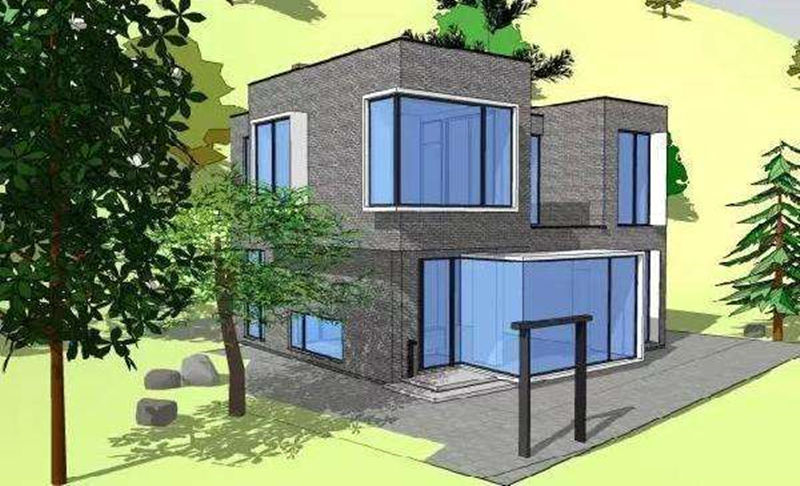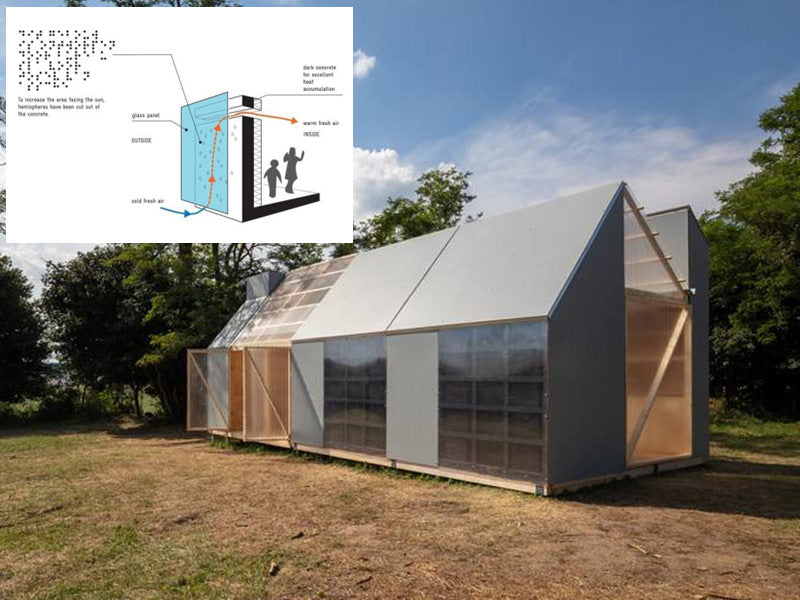
Main content:
From the perspective of solar heat utilization, passive solar houses can be divided into the following types:
(1) Direct benefit type: use the solar energy directly irradiated by the south window;
(2) Heat collection and heat storage wall type: the south wall is used for heat collection and heat storage;
(3) Additional sun room type: use the hot air in the sun room and the heat-storing south wall to store solar energy;
(4) Roof heat collection and heat storage type: use the roof for heat collection and heat storage;
(5) Natural circulation type: the heating cycle is carried out by using the thermosiphon effect;
(6) Combined type: the combination of greenhouse and direct benefit type and heat collection and heat storage wall type.
1. Direct benefit type sun room

The direct benefit structure is the simplest. The house itself is a heat collector and a heat accumulator, and the large glass windows on the sunny side (double-glazed windows are best used in severe cold areas) are used to receive direct sunlight. The floor and wall of the house are made into heat storage structures by adopting measures in line with heat absorption, such as dark cement floors or paving bricks. During the day it is used to store solar energy, and at night these surfaces become heat dissipation surfaces.
Direct-benefit solar houses generally require larger windows facing south or on the roof. In order to prevent excessive heat dissipation at night, these lighting parts must have thermal insulation measures to improve their thermal performance. In order to prevent overheating in summer, shading measures or overhanging structures must also be taken. Due to the limited solar energy obtained by direct benefit, the whole building must have good thermal insulation performance to make this system work. Therefore, the roof and walls should also be thermally insulated, such as adding foamed plastic ceilings or retaining walls to prevent heat loss. In order to prevent excessive heat dissipation and increase heat load at night, thermal insulation roller blinds can be used to cover. In addition, the strong natural light during the day can be reflected to the ceiling or the floor through a reflective device such as adjustable blinds to suppress glare and form indirect light to illuminate the room with natural light, which can save energy. Taking natural lighting and heating factors into consideration, the types and layers of window frames and glass should be reasonably selected to ensure airtight heat insulation, and a reasonable window-to-wall ratio and window-to-ground ratio should be determined. Studies have shown that double glazing with sealed window frames combined with adjustable blinds to prevent glare is one of the best options.
2. Heat collection and storage wall type
The method of thermal storage wall was proposed by Professor Trom-be, director of the Solar Energy Research Office of the French National Center for Scientific Research in 1967. Internationally known as the "Trumbo Wall". Later, in practical use, the architect Michel did a lot of work, so it is also called the "Trumbo-Michel wall" in the solar energy industry. When the thermal storage wall is applied to the building to exhaust air to the outside, it is also called a solar chimney. Its working principle is to apply a dark selective coating on the outer surface of the south-facing wall, and install glass at a certain distance from the wall to form an air interlayer, and use the "chimney effect" principle to heat the air in the interlayer, thereby generating hot pressure to drive air flow.
The heat collection and heat storage wall type does not completely rely on sunlight to directly enter the room. In winter, the south-facing vertical heat-collecting wall is mainly used to absorb the sunlight passing through the glass lighting surface, the temperature of the wall increases, and the air between the glass and the wall is heated. Due to the low density of hot air, the rising hot air enters the room for heating through the upper air vent, while the cooler air at the bottom of the room is automatically sucked into the air channel by the lower air vent to form a circulation. In summer, the air is heated and discharged from the exhaust hole, and the small window on the north side is opened, and the cool wind enters the room, which strengthens the air convection and reduces the room temperature. Therefore, the outer surface of the thermal storage wall is generally painted black or some kind of dark color in order to absorb sunlight effectively.
The adjustment method of the heat collection and storage wall type is as follows:
(1) In winter, the indoor air is heated by opening the upper and lower vents of the heat collecting wall to form circulating convection. When fresh air is required or the temperature of the outdoor air is suitable, the air inlet under the glass curtain wall can also be opened, and the downwind outlet of the heat collection wall can be closed to heat the outdoor air before entering the room.
(2) In summer, only the lower air outlet of the heat collection wall and the upper air outlet of the glass curtain wall are opened, and the hot pressure flow of the interlayer air is used to prevent the indoor overheating and take away part of the indoor waste heat.
3. Additional sun room

The additional solar room system is similar to the heat collection and heat storage system, except that the glass curtain wall is converted into a sun room, and the hot air in the sun room and the heat-storing south wall are used to store solar energy. The south wall in the sun room can be opened with windows, and the hot air in the sun room can be introduced into the room. This system is simple in structure and has little impact on the facade of the building.
This solar house is a hybrid product of direct benefit and collector wall technology. The basic structure is to attach the sun room to the south side of the house, with a wall (with doors, windows or ventilation holes) in the middle to separate the house from the sun. At virtually all times of the day, the temperature inside the additional sunroom is higher than the outside temperature, so the sunroom can both supply the room with solar heat and act as a buffer, reducing heat loss from the room, so that the adjoining part of the building with the sunlight obtains a mild environment. Since the sunlight is directly irradiated and heated by the sun, it itself plays the role of a direct benefit system. During the day, when the air temperature in the sun room is greater than the temperature of the adjacent room, the heat of the sun room is transferred to the adjacent room by convection through opening the door (or the ventilation hole on the window or the wall), and the rest of the time is closed.
4. Roof heat collection and storage type

In the roof heat collection and storage type, the roof is made into a shallow pool type heat collector. In this design, the roof does not have a thermal insulation layer, but only plays the role of load-bearing and enclosure. A thermal insulation cover plate that can be pushed and pulled on and off is installed on the top of the pool. The system heats in winter and cools in summer.
During the daytime in winter, open the insulation board to allow the water to fully absorb the radiant heat of the sun; at night, close the insulation board, the water has a large heat capacity and can store more heat. Most of the heat in the water is radiated from the roof to the room, and a small amount of heat is radiated from the ceiling to the room below to meet the needs of indoor heating at night.
During the day in summer, cover the roof insulation board to block direct sunlight, and the cooler water exposed at night the previous day absorbs the heat in the room below, so that the room temperature drops; at night, the insulation panels are turned on, and with the help of natural convection and radiation to the cool night sky, the water in the pool is cooled and prepared for the next day to absorb the heat in the room below.
The method of using the roof for heat collection and storage is not limited by structure and orientation. Using the roof as the indoor heat dissipation surface can make the room temperature uniform without affecting the indoor layout. Its better heat storage also reduces the air-conditioning load and reduces the environmental load.
The system is suitable for areas in the south where the summer is hot and the winter is very cold, such as the areas on both sides of the Yangtze River where the summer is hot and the winter is cold, providing cold and heat sources for both winter and summer.
5. Natural circulation sun room

The heat collector and heat accumulator of the natural circulation passive solar house are set separately and independently from the building, and it is suitable for the house built on the hillside. The heat collector is lower than the ground of the house, and the heat accumulator is set above the heat collector to form a height difference and utilize the heat convection circulation of the fluid. During the day, after the air (or water) in the solar collector is heated, it rises to its upper rock heat storage layer through the air duct (or water pipe when using water) with the help of the thermosiphon effect generated by the temperature difference; the hot air is cooled by the absorption of heat by the rock pile, and then flows to the bottom of the collector for the next cycle. At night, the rock heat storage is convectively heated to the heated room through the air outlet.
Both heating and liquid heating. Due to its complex structure, the application is limited.
6. Combined sun room

Several basic types of passive solar houses have their own unique characteristics. A system composed of two or more passive basic types is called a combined system. Combining different heating methods can form complementary and more efficient passive solar heating systems.

















